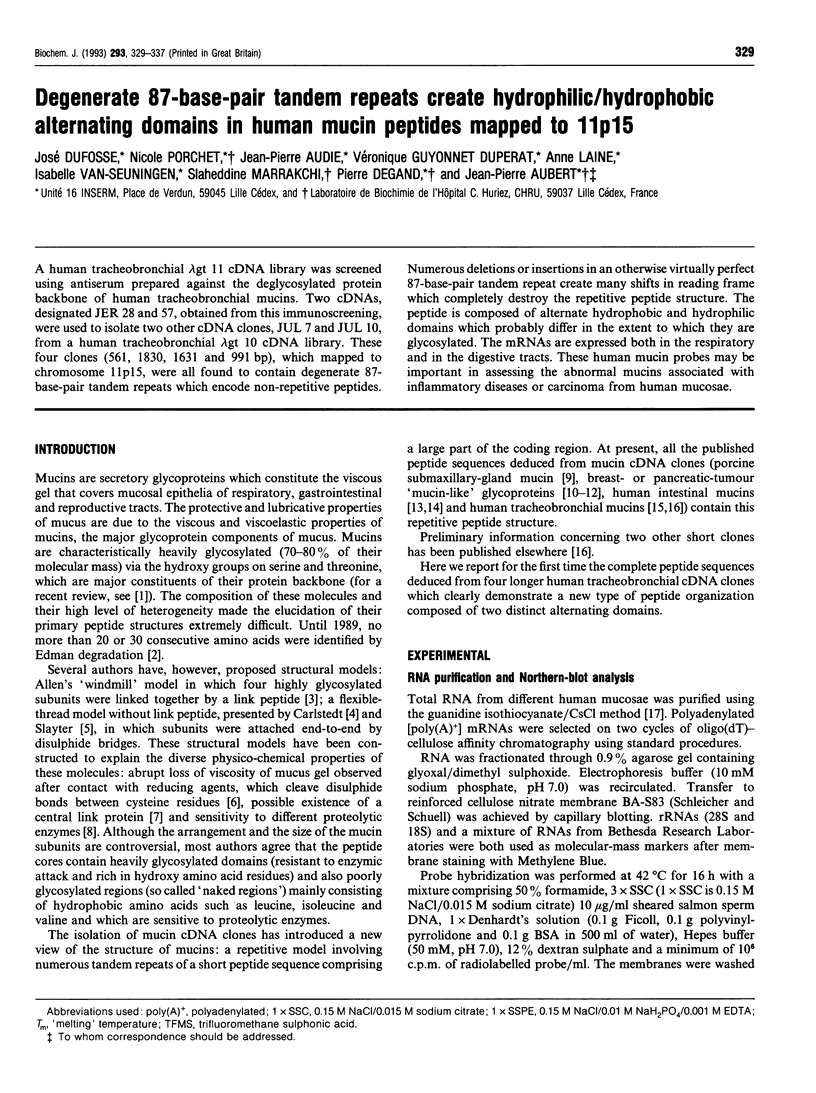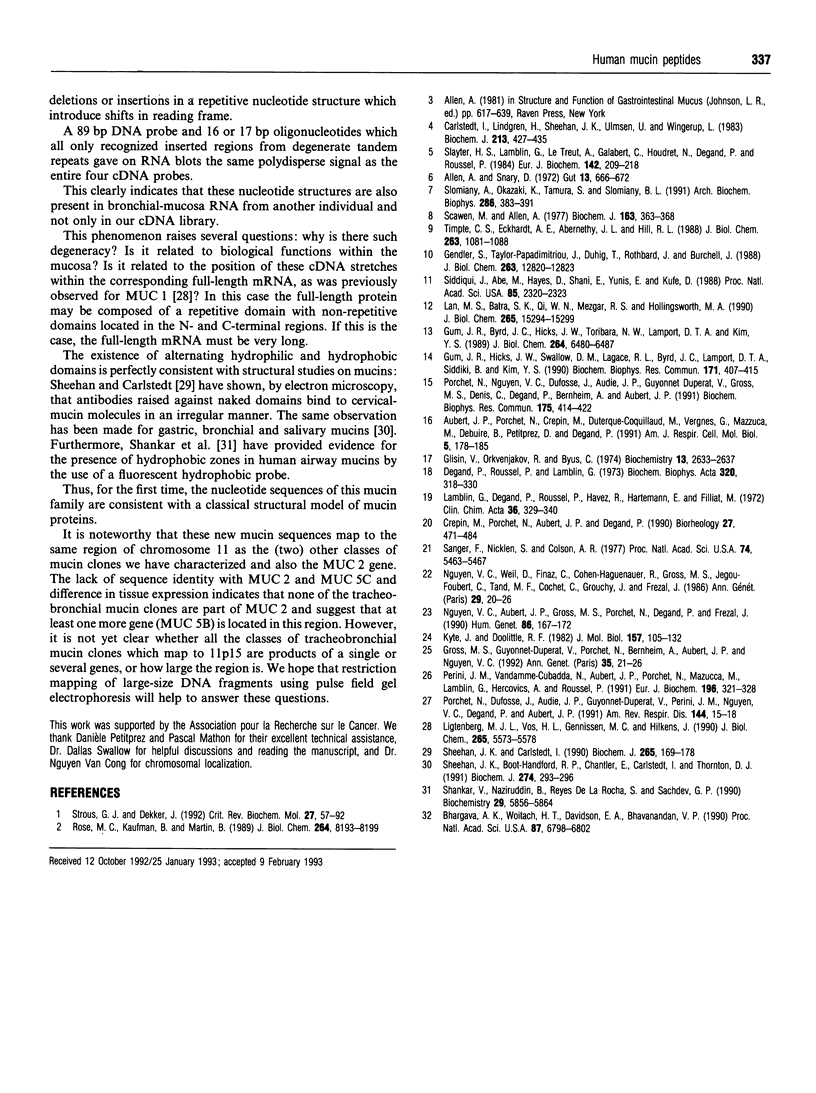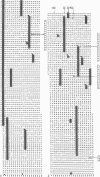Abstract
A human tracheobronchial lambda gt 11 cDNA library was screened using antiserum prepared against the deglycosylated protein backbone of human tracheobronchial mucins. Two cDNAs, designated JER 28 and 57, obtained from this immunoscreening, were used to isolate two other cDNA clones, JUL 7 and JUL 10, from a human tracheobronchial lambda gt 10 cDNA library. These four clones (561, 1830, 1631 and 991 bp), which mapped to chromosome 11p15, were all found to contain degenerate 87-base-pair tandem repeats which encode non-repetitive peptides. Numerous deletions or insertions in an otherwise virtually perfect 87-base-pair tandem repeat create many shifts in reading frame which completely destroy the repetitive peptide structure. The peptide is composed of alternate hydrophobic and hydrophilic domains which probably differ in the extent to which they are glycosylated. The mRNAs are expressed both in the respiratory and in the digestive tracts. These human mucin probes may be important in assessing the abnormal mucins associated with inflammatory diseases or carcinoma from human mucosae.
Full text
PDF








Images in this article
Selected References
These references are in PubMed. This may not be the complete list of references from this article.
- Allen A., Snary D. The structure and function of gastric mucus. Gut. 1972 Aug;13(8):666–672. doi: 10.1136/gut.13.8.666. [DOI] [PMC free article] [PubMed] [Google Scholar]
- Aubert J. P., Porchet N., Crepin M., Duterque-Coquillaud M., Vergnes G., Mazzuca M., Debuire B., Petitprez D., Degand P. Evidence for different human tracheobronchial mucin peptides deduced from nucleotide cDNA sequences. Am J Respir Cell Mol Biol. 1991 Aug;5(2):178–185. doi: 10.1165/ajrcmb/5.2.178. [DOI] [PubMed] [Google Scholar]
- Bhargava A. K., Woitach J. T., Davidson E. A., Bhavanandan V. P. Cloning and cDNA sequence of a bovine submaxillary gland mucin-like protein containing two distinct domains. Proc Natl Acad Sci U S A. 1990 Sep;87(17):6798–6802. doi: 10.1073/pnas.87.17.6798. [DOI] [PMC free article] [PubMed] [Google Scholar]
- Carlstedt I., Lindgren H., Sheehan J. K. The macromolecular structure of human cervical-mucus glycoproteins. Studies on fragments obtained after reduction of disulphide bridges and after subsequent trypsin digestion. Biochem J. 1983 Aug 1;213(2):427–435. doi: 10.1042/bj2130427. [DOI] [PMC free article] [PubMed] [Google Scholar]
- Crepin M., Porchet N., Aubert J. P., Degand P. Diversity of the peptide moiety of human airway mucins. Biorheology. 1990;27(3-4):471–484. doi: 10.3233/bir-1990-273-426. [DOI] [PubMed] [Google Scholar]
- Gendler S., Taylor-Papadimitriou J., Duhig T., Rothbard J., Burchell J. A highly immunogenic region of a human polymorphic epithelial mucin expressed by carcinomas is made up of tandem repeats. J Biol Chem. 1988 Sep 15;263(26):12820–12823. [PubMed] [Google Scholar]
- Glisin V., Crkvenjakov R., Byus C. Ribonucleic acid isolated by cesium chloride centrifugation. Biochemistry. 1974 Jun 4;13(12):2633–2637. doi: 10.1021/bi00709a025. [DOI] [PubMed] [Google Scholar]
- Gross M. S., Guyonnet-Duperat V., Porchet N., Bernheim A., Aubert J. P., Nguyen V. C. Mucin 4 (MUC4) gene: regional assignment (3q29) and RFLP analysis. Ann Genet. 1992;35(1):21–26. [PubMed] [Google Scholar]
- Gum J. R., Byrd J. C., Hicks J. W., Toribara N. W., Lamport D. T., Kim Y. S. Molecular cloning of human intestinal mucin cDNAs. Sequence analysis and evidence for genetic polymorphism. J Biol Chem. 1989 Apr 15;264(11):6480–6487. [PubMed] [Google Scholar]
- Gum J. R., Hicks J. W., Swallow D. M., Lagace R. L., Byrd J. C., Lamport D. T., Siddiki B., Kim Y. S. Molecular cloning of cDNAs derived from a novel human intestinal mucin gene. Biochem Biophys Res Commun. 1990 Aug 31;171(1):407–415. doi: 10.1016/0006-291x(90)91408-k. [DOI] [PubMed] [Google Scholar]
- Kyte J., Doolittle R. F. A simple method for displaying the hydropathic character of a protein. J Mol Biol. 1982 May 5;157(1):105–132. doi: 10.1016/0022-2836(82)90515-0. [DOI] [PubMed] [Google Scholar]
- Lamblin G., Degand P., Roussel P., Havez R., Hartemann E., Fillat M. Les glycopeptides du mucus bronchique fibrillaire dans la mucoviscidose. Clin Chim Acta. 1972 Feb;36(2):329–340. doi: 10.1016/0009-8981(72)90006-x. [DOI] [PubMed] [Google Scholar]
- Lan M. S., Batra S. K., Qi W. N., Metzgar R. S., Hollingsworth M. A. Cloning and sequencing of a human pancreatic tumor mucin cDNA. J Biol Chem. 1990 Sep 5;265(25):15294–15299. [PubMed] [Google Scholar]
- Ligtenberg M. J., Vos H. L., Gennissen A. M., Hilkens J. Episialin, a carcinoma-associated mucin, is generated by a polymorphic gene encoding splice variants with alternative amino termini. J Biol Chem. 1990 Apr 5;265(10):5573–5578. [PubMed] [Google Scholar]
- Nguyen Van Cong, Weil D., Finaz C., Cohen-Haguenauer O., Gross M. S., Jegou-Foubert C., de Tand M. F., Cochet C., de Grouchy J., Frezal J. Panel of twenty-five independent man-rodent hybrids for human genetic marker mapping. Ann Genet. 1986;29(1):20–26. [PubMed] [Google Scholar]
- Nguyen V. C., Aubert J. P., Gross M. S., Porchet N., Degand P., Frézal J. Assignment of human tracheobronchial mucin gene(s) to 11p15 and a tracheobronchial mucin-related sequence to chromosome 13. Hum Genet. 1990 Dec;86(2):167–172. doi: 10.1007/BF00197699. [DOI] [PubMed] [Google Scholar]
- Perini J. M., Vandamme-Cubadda N., Aubert J. P., Porchet N., Mazzuca M., Lamblin G., Herscovics A., Roussel P. Multiple apomucin translation products from human respiratory mucosa mRNA. Eur J Biochem. 1991 Mar 14;196(2):321–328. doi: 10.1111/j.1432-1033.1991.tb15820.x. [DOI] [PubMed] [Google Scholar]
- Porchet N., Nguyen V. C., Dufosse J., Audie J. P., Guyonnet-Duperat V., Gross M. S., Denis C., Degand P., Bernheim A., Aubert J. P. Molecular cloning and chromosomal localization of a novel human tracheo-bronchial mucin cDNA containing tandemly repeated sequences of 48 base pairs. Biochem Biophys Res Commun. 1991 Mar 15;175(2):414–422. doi: 10.1016/0006-291x(91)91580-6. [DOI] [PubMed] [Google Scholar]
- Rose M. C., Kaufman B., Martin B. M. Proteolytic fragmentation and peptide mapping of human carboxyamidomethylated tracheobronchial mucin. J Biol Chem. 1989 May 15;264(14):8193–8199. [PubMed] [Google Scholar]
- Sanger F., Nicklen S., Coulson A. R. DNA sequencing with chain-terminating inhibitors. Proc Natl Acad Sci U S A. 1977 Dec;74(12):5463–5467. doi: 10.1073/pnas.74.12.5463. [DOI] [PMC free article] [PubMed] [Google Scholar]
- Scawen M., Allen A. The action of proteolytic enzymes on the glycoprotein from pig gastric mucus. Biochem J. 1977 May 1;163(2):363–368. doi: 10.1042/bj1630363. [DOI] [PMC free article] [PubMed] [Google Scholar]
- Shankar V., Naziruddin B., Reyes de la Rocha S., Sachdev G. P. Evidence of hydrophobic domains in human respiratory mucins. Effect of sodium chloride on hydrophobic binding properties. Biochemistry. 1990 Jun 19;29(24):5856–5864. doi: 10.1021/bi00476a030. [DOI] [PubMed] [Google Scholar]
- Sheehan J. K., Boot-Handford R. P., Chantler E., Carlstedt I., Thornton D. J. Evidence for shared epitopes within the 'naked' protein domains of human mucus glycoproteins. A study performed by using polyclonal antibodies and electron microscopy. Biochem J. 1991 Feb 15;274(Pt 1):293–296. doi: 10.1042/bj2740293. [DOI] [PMC free article] [PubMed] [Google Scholar]
- Sheehan J. K., Carlstedt I. Electron microscopy of cervical-mucus glycoproteins and fragments therefrom. The use of colloidal gold to make visible 'naked' protein regions. Biochem J. 1990 Jan 1;265(1):169–177. doi: 10.1042/bj2650169. [DOI] [PMC free article] [PubMed] [Google Scholar]
- Siddiqui J., Abe M., Hayes D., Shani E., Yunis E., Kufe D. Isolation and sequencing of a cDNA coding for the human DF3 breast carcinoma-associated antigen. Proc Natl Acad Sci U S A. 1988 Apr;85(7):2320–2323. doi: 10.1073/pnas.85.7.2320. [DOI] [PMC free article] [PubMed] [Google Scholar]
- Slayter H. S., Lamblin G., Le Treut A., Galabert C., Houdret N., Degand P., Roussel P. Complex structure of human bronchial mucus glycoprotein. Eur J Biochem. 1984 Jul 16;142(2):209–218. doi: 10.1111/j.1432-1033.1984.tb08273.x. [DOI] [PubMed] [Google Scholar]
- Slomiany A., Okazaki K., Tamura S., Slomiany B. L. Identity of mucin's "118-kDa link protein" with fibronectin fragment. Arch Biochem Biophys. 1991 May 1;286(2):383–388. doi: 10.1016/0003-9861(91)90055-n. [DOI] [PubMed] [Google Scholar]
- Strous G. J., Dekker J. Mucin-type glycoproteins. Crit Rev Biochem Mol Biol. 1992;27(1-2):57–92. doi: 10.3109/10409239209082559. [DOI] [PubMed] [Google Scholar]
- Timpte C. S., Eckhardt A. E., Abernethy J. L., Hill R. L. Porcine submaxillary gland apomucin contains tandemly repeated, identical sequences of 81 residues. J Biol Chem. 1988 Jan 15;263(2):1081–1088. [PubMed] [Google Scholar]






